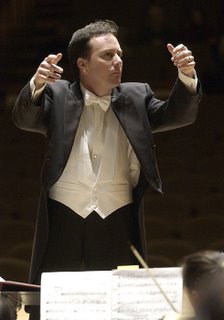
Ryan Brown, director of Opera Lafayette |
For interesting and beautifully performed programs of rare Baroque music, Washington listeners have Opera Lafayette. The historically informed performance (HIP) ensemble brought its season to a close on Sunday afternoon, with a survey of operas on the Don Juan legend at St. Paul's Lutheran Church. It was a fascinating conclusion to a season that opened with the first modern revival of a total obscurity, François Rebel and François Francoeur's Zélindor, roi des Sylphes, which they also performed in New York (see Anne Midgette's review for the New York Times). Naxos will release Opera Lafayette's recording of the work in 2009.
The legendary seducer of women is likely a folk myth in origin, but we generally trace him first in literature to a play by Tirso de Molina (né Gabriel Téllez) called El burlador de Sevilla y convidado de piedra (The Trickster of Seville and the Stone Guest), from 1630. As described by Charles C. Russell in his book The Don Juan Legend before Mozart (University of Michigan Press, 1993), the story was a popular source for opera libretti before Mozart and Da Ponte got to it. What this selection of excerpts from Don Juan operas before Don Giovanni showed was what we have known for some time: while Mozart and Da Ponte's work relied on its predecessors, some more heavily than others, it far exceeded them in terms of dramatic ingenuity and musical brilliance.
Mozart certainly knew the music of Gluck's Don Juan (Vienna, 1761), a pantomime ballet created with Gasparo Angiolini, which opened this concert. Guided by the full-body, choreographic conducting of Opera Lafayette's artistic director, Ryan Brown, the orchestra of HIP instruments gave a suave reading of excerpts from this pleasing score. The serenade of Don Juan was a pastoral 6/8 Andante, with the solo oboe (struggling with tuning issues at the opening of the concert) accompanied by pizzicato strings. Other selections that are reminiscent of Mozart's opera are the accented strokes for the knock of the Stone Guest and some of the minor-mode angst of the damnation scene. The Dance of the Furies from that concluding scene (they issue forth in flames from Hell, to drag Don Juan away in chains) is the most famous music from the ballet (used again for the Furies in Orphée et Eurydice), but it is the Fandango, played here with charming castanets, that Mozart quoted in Le Nozze di Figaro.
The earliest opera selected here was Alessandro Melani's L'Empio Punito (1669, Rome). It featured two talented singers from the University of Maryland and a chamber assortment of instruments, including Ryan Brown on first violin. Adria McCulloch (the best part of a recent performance of Gluck's Armide) brought her powerful, dark soprano to the role of Atamira (who corresponds to Mozart's Donna Elvira), and Meghan McCall (reviewed last spring in Conrad Susa's Transformations) as Acrimante, the first Don Juan of the evening, a clear, silvery treble. The two gave a lovely performance in one of the opera's simple but effective duets (Assistimi Amore / Resisti mio core), while effervescent tenor Jean-Paul Fouchécourt camped it up in an aria for Delfa, an old woman who has also fallen for Acrimante. The most beautiful piece from this opera was Acrimante's slow minor-key aria Se d'Amor la cruda sfinge, sung with clarity by McCall and a heart-rending manipulation of the clashing dissonances between the two violin parts.
The major discovery of the concert was a new transcription of a section of Gioacchino Albertini's Il Don Giovanni (Warsaw, 1780), based on a manuscript given to Ryan Brown by Charles C. Russell (whose book was cited above -- hooray, musicology!). Far beyond the musicological interest (which made the scholarly side of my heart sing), the buffo escapades of bass-baritone François Loup as Ercolino (Leporello) made this modern premiere such a lark. With the imprecision of his now-tired high baritone range aside, Loup's rabid patter and falsetto imitation of a castrato (part of an extended monologue to entertain baritone William Sharp's Don Giovanni) were hysterical. 
Jean-Paul Fouchécourt, tenor |
The libretto of Gazzaniga's Il Don Giovanni, which premiered only six months before Mozart's opera, was the direct model referenced extensively by Da Ponte. The selections here (Act I, scenes 1 and 2) was copied rather closely by Da Ponte, with William Sharp as Pasquariello (Leporello) waiting outside while Don Giovanni (now the tenor Fouchécourt) seduced Meghan McCall's Donna Anna, followed by the murder of the Commendatore (Loup).
Finally, the Mozart selection took up exactly where the Gazzaniga left off, with Don Ottavio consoling Donna Anna and swearing to avenge her father's murderer. Surely, somewhere in the background of this performance was the groundbreaking recording of Don Giovanni released last fall by René Jacobs and the Freiburger Barockorchester. Once you have heard the more transparent orchestral texture of the score when played by original instruments, it is hard to go back to modern ones, although Brown happily eschewed the ultra-fast tempi for many numbers that Jacobs chose.
The lighter instrumental background made possible the angelic rendition of Dalla sua pace by Fouchécourt's Don Ottavio, in which he could truly sigh without fear of being covered. The ethereal flutes provided a striking contrast to the thick, reedy sound of Millicent Scarlett's Donna Anna, although they did have one early entrance in the same scene (Act I, scene 3). The oboes and brass had more than their accustomed number of splats, and a general instability of ensemble (most noticeable in discombobulation in fast numbers like the Dance of the Furies) may be credited to the unusual arrangement of the players in the church's limited altar space.
Opera Lafayette's 2008-2009 season has not been fully announced yet, but it will feature the modern American premiere of Pierre-Alexandre Monsigny's Le Déserteur (1769), to be presented both here and in New York. The group will also make its Kennedy Center debut.























































No comments:
Post a Comment